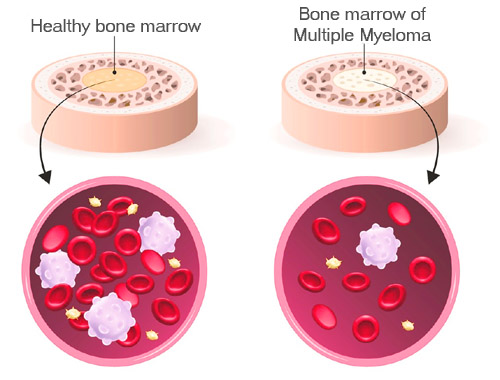Multiple Myeloma

Published: 18 Jun 2025
ICD9: 203.0 ICD10: C90.0 ICD11: 2A83.1
Multiple myeloma is a type of cancer that affects plasma cells, which are a type of white blood cell found in the bone marrow.
These plasma cells normally make antibodies to help fight infection.
Here's a more detailed breakdown:
![]() The Problem: In multiple myeloma, abnormal plasma cells accumulate in the bone marrow and crowd out healthy blood cells. These myeloma cells also produce abnormal antibodies (called monoclonal protein or M protein) that don't fight infection effectively and can cause various problems.
The Problem: In multiple myeloma, abnormal plasma cells accumulate in the bone marrow and crowd out healthy blood cells. These myeloma cells also produce abnormal antibodies (called monoclonal protein or M protein) that don't fight infection effectively and can cause various problems.
![]() Where it Starts: It primarily develops in the bone marrow, which is the soft tissue inside bones where blood cells are made.
Where it Starts: It primarily develops in the bone marrow, which is the soft tissue inside bones where blood cells are made.
![]() Why it's called "Multiple": The term "multiple" refers to the fact that the cancer often affects multiple areas in the body, such as different bones. The myeloma cells can form tumors in the bones.
Why it's called "Multiple": The term "multiple" refers to the fact that the cancer often affects multiple areas in the body, such as different bones. The myeloma cells can form tumors in the bones.
Key Features and Complications:
![]() Bone Problems: Bone pain (especially in the back, ribs, and hips), fractures, and weakened bones are common due to the myeloma cells damaging the bone. This is often the first symptom people notice.
Bone Problems: Bone pain (especially in the back, ribs, and hips), fractures, and weakened bones are common due to the myeloma cells damaging the bone. This is often the first symptom people notice.
![]() Anemia: Myeloma cells crowd out healthy red blood cells, leading to anemia (low red blood cell count), which causes fatigue and weakness.
Anemia: Myeloma cells crowd out healthy red blood cells, leading to anemia (low red blood cell count), which causes fatigue and weakness.
![]() Kidney Problems: The abnormal M protein can damage the kidneys, leading to kidney failure.
Kidney Problems: The abnormal M protein can damage the kidneys, leading to kidney failure.
![]() Hypercalcemia: The breakdown of bone can release calcium into the bloodstream, leading to hypercalcemia (high calcium levels), which can cause confusion, constipation, and other problems.
Hypercalcemia: The breakdown of bone can release calcium into the bloodstream, leading to hypercalcemia (high calcium levels), which can cause confusion, constipation, and other problems.
![]() Weakened Immune System: Because the abnormal plasma cells don't produce functional antibodies, people with multiple myeloma are more susceptible to infections.
Weakened Immune System: Because the abnormal plasma cells don't produce functional antibodies, people with multiple myeloma are more susceptible to infections.
![]() Symptoms (often abbreviated as CRAB): The classic symptoms of multiple myeloma are often remembered by the acronym CRAB:
Symptoms (often abbreviated as CRAB): The classic symptoms of multiple myeloma are often remembered by the acronym CRAB:![]()

![]() Calcium elevation (hypercalcemia)
Calcium elevation (hypercalcemia)![]()

![]() Renal insufficiency (kidney problems)
Renal insufficiency (kidney problems)![]()

![]() Anemia
Anemia![]()

![]() Bone lesions/pain
Bone lesions/pain
Diagnosis:
Diagnosis typically involves:
![]() Blood and Urine Tests: To detect abnormal proteins (M protein) and other markers.
Blood and Urine Tests: To detect abnormal proteins (M protein) and other markers.
![]() Bone Marrow Biopsy: To examine the bone marrow for the presence of myeloma cells.
Bone Marrow Biopsy: To examine the bone marrow for the presence of myeloma cells.
![]() Imaging Tests: X-rays, MRI, CT scans, or PET scans to detect bone damage.
Imaging Tests: X-rays, MRI, CT scans, or PET scans to detect bone damage.
Treatment:
Treatment options for multiple myeloma have improved significantly in recent years. Treatment depends on factors such as the stage of the disease, the patient's overall health, and their risk factors. Common treatments include:
![]() Chemotherapy: Drugs to kill cancer cells.
Chemotherapy: Drugs to kill cancer cells.
![]() Targeted Therapy: Drugs that target specific vulnerabilities in myeloma cells.
Targeted Therapy: Drugs that target specific vulnerabilities in myeloma cells.
![]() Immunotherapy: Drugs that help the immune system attack cancer cells.
Immunotherapy: Drugs that help the immune system attack cancer cells.
![]() Stem Cell Transplant: Replacing damaged bone marrow with healthy bone marrow (either the patient's own or from a donor).
Stem Cell Transplant: Replacing damaged bone marrow with healthy bone marrow (either the patient's own or from a donor).
![]() Radiation Therapy: To treat localized bone pain or tumors.
Radiation Therapy: To treat localized bone pain or tumors.
![]() Supportive Care: To manage symptoms and complications, such as pain management, treatment for anemia, and prevention of infections.
Supportive Care: To manage symptoms and complications, such as pain management, treatment for anemia, and prevention of infections.
Important Considerations:
![]() Multiple myeloma is generally considered a chronic, but treatable, cancer. Many people with multiple myeloma can live for many years with treatment.
Multiple myeloma is generally considered a chronic, but treatable, cancer. Many people with multiple myeloma can live for many years with treatment.
![]() The prognosis (outlook) varies depending on the stage of the disease, the patient's overall health, and how well they respond to treatment.
The prognosis (outlook) varies depending on the stage of the disease, the patient's overall health, and how well they respond to treatment.
Disclaimer: This information is for general knowledge and informational purposes only, and does not constitute medical advice. It is essential to consult with a qualified healthcare professional for any health concerns or before making any decisions related to your health or treatment. If you suspect you or someone you know may have multiple myeloma, please seek immediate medical attention.